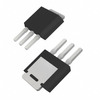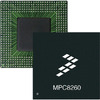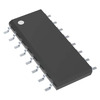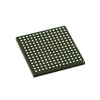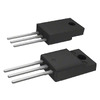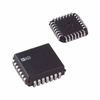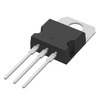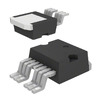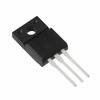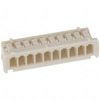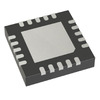Understanding the MAX31855 Cold-Junction Converter: Pinout, Features, Applications, and Datasheet
The MAX31855 is a versatile thermocouple-to-digital converter known for its high accuracy and wide-ranging temperature measurement capabilities. It supports multiple thermocouple types, including K, J, and T, and delivers precise 14-bit data with the help of integrated cold-junction compensation. Its ability to measure extreme temperatures, ranging from -270°C to +1800°C, makes it ideal for demanding applications like industrial monitoring and scientific research. In addition, its compatibility with microcontroller systems through an SPI interface enhances ease of integration, positioning the MAX31855 as a reliable solution for precision temperature control and monitoring across various industries.Catalog
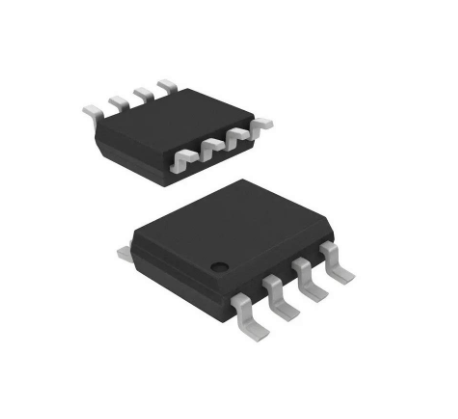
MAX31855 Overview
The MAX31855 acts as a sophisticated link between thermocouples and digital systems, featuring a 14-bit ADC with integrated cold-junction compensation. It enhances the precision of temperature monitoring by connecting seamlessly with microcontrollers (µC). Various versions accommodate different thermocouple types, identifiable by suffixes such as MAX31855K.
Temperature Conversion
The MAX31855 processes thermocouple signals for ADC compatibility, minimizing noise interference. It compensates for environmental temperature variations by aligning thermal voltage to a 0°C benchmark. For K-type thermocouples, voltage shifts approximately 41µV/°C, expressed as
VOUT = (41.276µV/°C) x (TR - TAMB)
Each thermocouple type exhibits distinct traits, necessitating adjustments to address their non-linear performance.
Cold-Junction Compensation
This component identifies temperature disparities across the thermocouple junctions, managing these with cold-junction compensation by synchronizing its internal die temperature to the reference junction. By incorporating this temperature into the raw thermocouple data, it yields accurate "hot junction" readings. Placing the device strategically, so the cold junction and MAX31855 share similar temperatures, enriches measurement consistency. You can often position this in settings with stable temperatures, cherishing the reliability it brings to those who are deeply invested in the distinctions of thermal measurement.
Pin Configuration

CAD Model of MAX31855
Symbolic Representation

Board Layout

3D Model
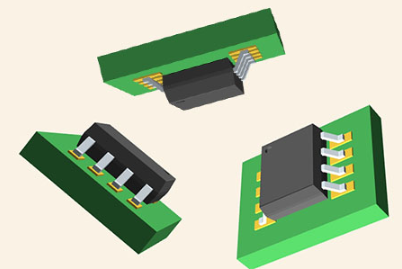
Features
|
Feature |
Description |
|
Integration Reduces Design Time |
Lowers system cost by simplifying the design process. |
|
14-Bit, 0.25°C Resolution Converter |
Provides high accuracy temperature measurements. |
|
Integrated Cold-Junction Compensation |
Automatically compensates for cold-junction temperature. |
|
Supports Multiple Thermocouple Types |
Compatible with K-, J-, N-, T-, S-, R-, and E-Type
thermocouples. |
|
Thermocouple Shorts Detection |
Detects shorts to GND or VCC, improving system
reliability. |
|
Open Thermocouple Detection |
Identifies when the thermocouple is disconnected. |
|
Microcontroller Interface Compatibility |
Easily interfaces with most microcontrollers. |
|
SPI-Compatible Interface |
Simple read-only SPI interface for easy data
communication. |
Technical Specification
Here’s the table based on the provided specifications for the Maxim Integrated MAX31855TASA+.
|
Type |
Parameter |
|
Factory Lead Time |
6 Weeks |
|
Mounting Type |
Surface Mount |
|
Package / Case |
8-SOIC (0.154, 3.90mm Width) |
|
Surface Mount |
YES |
|
Number of Pins |
8 |
|
Weight |
506.605978mg |
|
Operating Temperature |
-40°C ~ 125°C |
|
Packaging |
Tube |
|
Published |
2013 |
|
Pbfree Code |
YES |
|
Part Status |
Active |
|
Moisture Sensitivity Level (MSL) |
1 (Unlimited) |
|
Number of Terminations |
8 |
|
ECCN Code |
EAR99 |
|
Type |
Thermocouple to Digital Converter |
|
Terminal Position |
DUAL |
|
Terminal Form |
GULL WING |
|
Peak Reflow Temperature (Cel) |
NOT SPECIFIED |
|
Number of Functions |
1 |
|
Supply Voltage |
3.3V |
|
Terminal Pitch |
1.27mm |
|
Time @ Peak Reflow Temperature-Max (s) |
NOT SPECIFIED |
|
Base Part Number |
MAX31855 |
|
Pin Count |
8 |
|
Qualification Status |
Not Qualified |
|
Output Type |
Digital |
|
Operating Supply Voltage |
3.3V |
|
Interface |
SPI |
|
Max Supply Voltage |
3.6V |
|
Min Supply Voltage |
3V |
|
Operating Supply Current |
900μA |
|
Input Type |
Thermocouple (Multiple) |
|
Supply Current-Max (Isup) |
1.5mA |
|
Resolution |
1.75 B |
|
Length |
4.9mm |
|
Height Seated (Max) |
1.75mm |
|
Width |
3.9mm |
|
REACH SVHC |
Unknown |
|
RoHS Status |
ROHS3 Compliant |
Functional Block Diagram of MAX31855
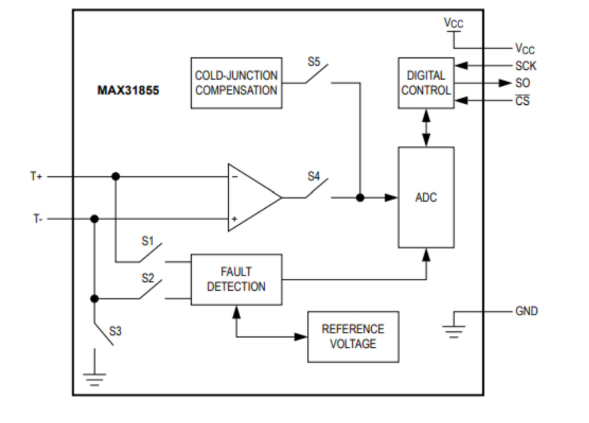
Comparable Substitutes
|
Part Number |
Descriptions |
Manufacturer |
|
MAX31855NASA+SIGNAL CIRCUITS |
Analog Circuit, 1 Func, PDSO8, ROHS COMPLIANT, SOP-8 |
Maxim Integrated Products |
Parts with Similar Specs of MAX31855
|
Part Number |
Manufacturer |
Package / Case |
Number of Pins |
Number of Terminations |
Pbfree Code |
RoHS Status |
Packaging |
Terminal Position |
|
MAX31855TASA+ |
Maxim Integrated |
8-SOIC (0.154, 3.90mm) |
8 |
8 |
Yes |
ROHS3 Compliant |
Tube |
DUAL |
|
TC4427EOA |
Microchip Technology |
8-SOIC (0.154, 3.90mm) |
8 |
8 |
Yes |
ROHS3 Compliant |
Tube |
DUAL |
|
TC7662BCOA |
Microchip Technology |
8-SOIC (0.154, 3.90mm) |
8 |
8 |
Yes |
ROHS3 Compliant |
Tube |
DUAL |
|
MCP1404-E/SN |
Microchip Technology |
8-SOIC (0.154, 3.90mm) |
8 |
8 |
Yes |
ROHS3 Compliant |
Tube |
DUAL |
Typical Application Circuit of MAX31855
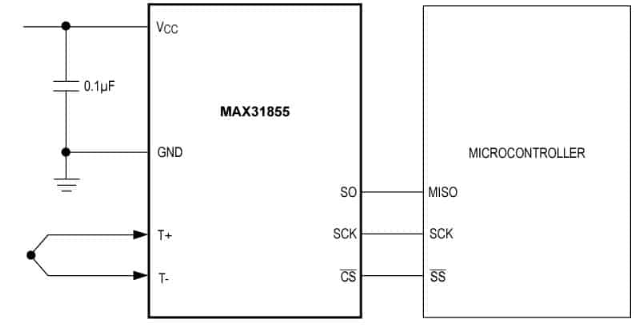
Serial-Interface Diagrams of MAX31855
Timing

Protocols

Uses Variations
Industrial Systems
The impact of cutting-edge systems in industrial contexts lies in enhancing productivity and streamlining operations. Automation, data analytics, and IoT are integral to these advancements. A notable aspect is the focus on predictive maintenance leveraging machine learning to prevent disruptions. For instance, factories now employ sensors to continuously monitor equipment health, providing insights that forestall unexpected breakdowns. The transformation of smart factories has redefined industry approaches to innovation and market adaptation.
Home Appliances
Today's home appliances are more interconnected, playing a role in the evolving smart home landscape. Emphasizing energy efficiency and comfort, they harness to understand habits and optimize settings. Picture refrigerators alerting you to expiring items or washing machines calibrating water usage based on load size. These innovations enhance convenience while supporting sustainable living. The movement towards eco-friendly technologies mirrors societal values of mindful consumption.
HVAC Units
Heating, ventilation, and air conditioning systems contribute significantly to indoor environmental quality. Modern HVAC units use smart thermostats and sensors to adjust the temperature based on occupancy and weather, improving both comfort and energy consumption. The growing integration of renewable energy, like solar panels, highlights a move towards cutting carbon emissions. Innovations in air filtration also play a part in improving air quality and supporting health through preventive measures. The efficiency focus in HVAC systems aligns the desire for comfort with the pursuit of environmental stewardship.
MAX31855 Packaging and Dimensions
|
PACKAGE TYPE |
PACKAGE CODE |
OUTLINE NO. |
LAND PATTERN NO. |
|
8 SO |
S8#4 |
21-0041 |
90-0096 |
About the Manufacturer
Maxim Integrated, now a basic part of Analog Devices, brings exceptional expertise in analog and mixed-signal integrated circuits. The company's dedication to sectors like automotive, industrial, and communications has positioned it as a prominent entity in these areas.
Their diverse array of products includes power management solutions, advanced sensors, and robust microcontrollers. These offerings aim to enhance efficiency and functionality, catering to the complex demands of modern electronic systems. Precision in sensor data processing, for instance, plays a major role in automotive safety features, emphasizing the need for meticulous design and execution.
Based in San Jose, California, Maxim Integrated has a remarkable global footprint with numerous facilities and offices across continents. This widespread presence facilitates collaboration with various industries and supports the seamless integration of their technologies in different regional settings. Forming local partnerships has been beneficial in developing solutions that align with specific regulatory and market requirements.
Datasheet PDF
TC4427EOA Datasheets:
TC7662BCOA Datasheets:
Analog and Interface Product Guide.pdf
MCP1404-E/SN Datasheets:
Cylindrical Battery Holders.pdf
Frequently Asked Questions [FAQ]
1. What is MAX31855?
The MAX31855 is a sophisticated integrated circuit designed to convert thermocouple signals into digital form. It integrates precise cold-junction compensation, yielding a 14-bit digital output via an SPI interface. Its role is notable in scenarios where temperature precision is active. In industrial environments, its dependability and precision are often likened to traditional methods, showcasing how digital data precision elevates automated processes. This transition from analog to digital streamlines temperature monitoring systems, bolstering their efficiency.
2. How do thermistors and thermocouples differ?
Thermistors and thermocouples are requisite in temperature measurement, each operating on distinct underlying principles. Thermistors change resistance with temperature fluctuations. They are highly sensitive and ideal for narrow ranges. Thermocouples generate a voltage between two different metals, allowing them to cover extensive temperature ranges and respond swiftly. Leveraging these sensors involves a deep understanding of their unique characteristics. This permits tailored selection for specific applications, significantly enhancing temperature monitoring efficacy in consumer electronics and intricate engineering systems.
About us
ALLELCO LIMITED
Read more
Quick inquiry
Please send an inquiry, we will respond immediately.

LMR400 vs RG213: The Ultimate Cable Comparison for Performance and Value
on October 24th
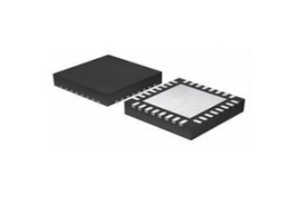
Exploring the LTC3780 Buck-Boost Controller
on October 24th
Popular Posts
-

What is GND in the circuit?
on January 1th 2924
-

RJ-45 Connector Guide: RJ-45 Connector Color Codes, Wiring Schemes, R-J45 Applications, RJ-45 Datasheets
on January 1th 2484
-

Fiber Connector Types: SC Vs LC And LC Vs MTP
on January 1th 2075
-

Understanding Power Supply Voltages in Electronics VCC, VDD, VEE, VSS, and GND
on November 8th 1863
-

Comparison Between DB9 and RS232
on January 1th 1756
-

What Is An LR44 Battery?
Electricity, that ubiquitous force, quietly permeates every aspect of our daily lives, from trivial gadgets to life-threatening medical equipment, it plays a silent role. However, truly grasping this energy, especially how to store and efficiently output it, is no easy task. It is against this background that this article will focus on a type of coin cell battery that may seem insignificant on the...on January 1th 1706
-

Understanding the Fundamentals:Inductance Resistance, andCapacitance
In the intricate dance of electrical engineering, a trio of fundamental elements takes center stage: inductance, resistance, and capacitance. Each bears unique traits that dictate the dynamic rhythms of electronic circuits. Here, we embark on a journey to decipher the complexities of these components, to uncover their distinct roles and practical uses within the vast electrical orchestra. Inductan...on January 1th 1649
-

CR2430 Battery Comprehensive Guide: Specifications, Applications and Comparison to CR2032 Batteries
What is CR2430 battery ?Benefits of CR2430 BatteriesNormCR2430 Battery ApplicationsCR2430 EquivalentCR2430 VS CR2032Battery CR2430 SizeWhat to look for when buying the CR2430 and equivalentsData Sheet PDFFrequently Asked Questions Batteries are the heart of small electronic devices. Among the many types available, coin cells play a crucial role, commonly found in calculators, remote controls, and ...on January 1th 1536
-

What Is RF and Why Do We Use It?
Radio Frequency (RF) technology is a key part of modern wireless communication, enabling data transmission over long distances without physical connections. This article delves into the basics of RF, explaining how electromagnetic radiation (EMR) makes RF communication possible. We will explore the principles of EMR, the creation and control of RF signals, and their wide-ranging uses. The article ...on January 1th 1526
-

CR2450 vs CR2032: Can The Battery Be Used Instead?
Lithium manganese batteries do have some similarities with other lithium batteries. High energy density and long service life are the characteristics they have in common. This kind of battery has won the trust and favor of many consumers because of its unique safety. Expensive tech gadgets? Small appliances in our homes? Look around and you'll see them everywhere. Among these many lithium-manganes...on January 1th 1497



